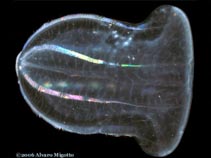Beroe ovata Bruguière, 1789
Brown comb jelly| Native range | All suitable habitat | Point map | Year 2050 |

|
| This map was computer-generated and has not yet been reviewed. |
| Beroe ovata AquaMaps Data sources: GBIF OBIS |
Classification / Names Common names | Synonyms | CoL | ITIS | WoRMS
Nuda | Beroida | Beroidae
Environment: milieu / climate zone / depth range / distribution range Ecology
Pelagic; depth range 0 - 1719 m (Ref. 108074). Subtropical
Distribution Countries | FAO areas | Ecosystems | Occurrences | Introductions
Indo-West Pacific, Atlantic Ocean, and the Mediterranean.
Length at first maturity / Size / Weight / Age
Maturity: Lm ? range ? - ? cm Max length : 11.5 cm H male/unsexed; (Ref. 1610)
Life cycle and mating behavior Maturity | Reproduction | Spawning | Eggs | Fecundity | Larvae
Main reference
References | Coordinator | Collaborators
Hernandez-Nicaise, M.L., G.O. Mackie and R.W. Meech 1980 Giant Smooth Muscle Cells of Beroë. The Journal of General Physiology 75:79-105. (Ref. 1096)
IUCN Red List Status
(Ref. 130435: Version 2025-1)
CITES status (Ref. 108899)
CMS (Ref. 116361)
Threat to humans
Human uses
| FishSource |
Tools
More information
Max. ages / sizes
Length-weight rel.
Length-length rel.
Length-frequencies
Mass conversion
Abundance
Internet sources
BHL | BOLD Systems | CISTI | DiscoverLife | FAO(Publication : search) | Fishipedia | GenBank (genome, nucleotide) | GloBI | Gomexsi | Google Books | Google Scholar | Google | PubMed | Tree of Life | Wikipedia (Go, Search) | Zoological Record



